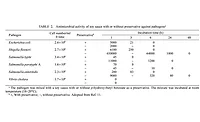Food Safety: Listeria and RTE foods, A step in the right direction?
RECENTLY THERE HAVE BEEN SIGNIFIcant documents published on Listeria monocytogenes and ready-to-eat (RTE) foods. The most far-reaching of these is the new USDA/FSIS regulation on Control of Listeria monocytogenes in Ready-to-Eat Meat and Poultry. The ruling calls for all meat and poultry establishments producing RTE products that are exposed to the environment after cooking to develop written programs to control Listeria monocytogenes and to verify the effectiveness of those programs through testing. Testing data and plant-generated information relevant to their controls also must be shared with FSIS. The rule also encourages all plants to employ additional and more effective Listeria monocytogenes measures listed below.
1. Plants must employ both a post-lethality treatment and a growth inhibitor for Listeria monocytogenes on RTE products.
2. Operators must employ either a post-lethality treatment or a growth inhibitor for the pathogen on RTE products. Establishments choosing this alternative will be subject to more frequent FSIS verification activity than those choosing alternative 1.
3. An operation may employ sanitation measures only. Plants choosing this alternative will be targeted with even more frequent verifications. The Agency will place increased scrutiny on operations that produce hot dogs and deli meats.
Other Listeria-related documents are a pair of articles published in the April 2003 edition of Journal of Food Protection, prepared by National Food Processors Association (NFPA). The first is entitled “Survey of Listeria monocytogenes in Ready-to-Eat Foods” and the second “Listeria monocytogenes: Low Level Equals Low Risk.” The piece focuses on the most comprehensive work ever completed on the prevalence of the pathogen in the food supply. Nearly 32,000 samples were collected from eight categories of food (one of which was luncheon meats) and tested for both the presence and numbers of the pathogen. All samples were collected from retail markets. Luncheon meats made up the largest number of samples, including products that were sliced in-store and at the manufacturing site. Only 82 or 0.89% of the samples was found to contain the pathogen and only eight samples exceeded 100 or 102 Listeria monocytogenes per gram.
The Canadian government and several European Union nations have set a maximum limit for Listeria monocytogenes of 100 colony forming units per gram. If the US applied these standards, only 0.087% of the samples would have been in violation. Using the data collected in the survey and both statistics and the principles of risk assessment, the authors concluded that low levels of Listeria monocytogenes do not pose a significant health risk. The piece further suggests that US regulatory agencies consider adopting a non-zero risk policy and encourage development and adoption of technologies, such as hurdles, that will minimize the growth of the pathogen in foods. FDA risk assessment experts agreed with the direction proposed in the NFPA publication, but why is the same not true for FSIS?
The rule itself does not seem to be written to protect the public health. But the comments that precede the actual regulation and the appendix do. The emphasis on adoption of new technologies and interventions to control or eliminate the pathogen are excellent. The real question is whether testing will really help achieve product safety.
Both the USDA and FDA have supported HACCP for many years and were active partners on the National Academy of Sciences (NAS) team that produced the report, “An Evaluation of the Role of Microbiological Criteria for Foods and Food Ingredients” in 1985. This document jump-started the move toward adoption of HACCP by the US food industry. One of its basic tenets was that HACCP was the best means to assure the production of safe foods. HACCP depends on process control, not testing.
Consumer groups have lobbied for more testing as a means of assuring food safety, but industry experts understand that one cannot achieve quality or safety through more tests.
Looking for a reprint of this article?
From high-res PDFs to custom plaques, order your copy today!







